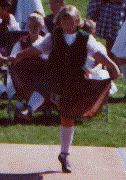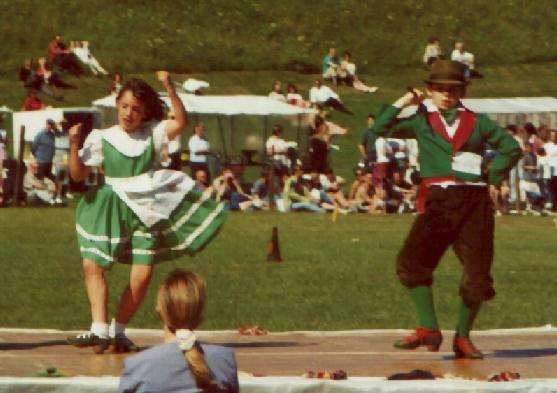| Lethbridge Highland |
| Dance Association |
|
|
Highland dancing covers a number of different dance steps, including what
are termed "national dances", based on traditional dances from Scotland that
have been standardised by an international body, the SOBHD. The ones learnt
by most students of highland dancing are the fling, the sword, the seann
truibhas, the lilt, the flora, the hornpipe and the jig, among others. Most
such dances are solitary affairs, although occasionally the highland reel and
strathspey -- involving four dancers at a time -- can be seen being performed at
dance competitions by more senior dancers.
 The most familiar of these dances is probably the (highland) fling, and is
usually danced to 32 bars of a lively strathspey. Popular tunes for this step
are the "Marquis of Huntly Highland Fling" or combinations of shorter
strathspeys like "Devil in the Kitchen" and "Orange and Blue". The dance is an
athletic one, and is celebratory. Folklore has it that it would have been danced
as a victory dance after battle atop the shield (with central spike) of a
successful combatant (most highland dances were traditionally
performed by men; in more modern times, the balance has swung to women).
The most familiar of these dances is probably the (highland) fling, and is
usually danced to 32 bars of a lively strathspey. Popular tunes for this step
are the "Marquis of Huntly Highland Fling" or combinations of shorter
strathspeys like "Devil in the Kitchen" and "Orange and Blue". The dance is an
athletic one, and is celebratory. Folklore has it that it would have been danced
as a victory dance after battle atop the shield (with central spike) of a
successful combatant (most highland dances were traditionally
performed by men; in more modern times, the balance has swung to women).
Another dance likely recognisable to most is the sword dance. This is
performed to a two part strathspey -- usually to the tune "Gillie Callum" --
where the tune begins slowly as a dancer negotiates the area outside a pair of
crossed swords laying on the ground. At one point in the dance, the dancer claps
hands to signal to the piper to pick up the tempo at which point the dancer
performs delicate footwork near the point where swords cross. According to lore,
the sword dance would have been performed prior to battle, and touching the
swords during the dance (apart from being a potentially bloody affair) would
have been taken as an ill omen of the looming battle's outcome. When younger
dancers are learning the sword dance, they often do so in stages, first learning
a step called the "pas de basque" (pronounced "pah-dee-bah") and then a more
involved form with an embellishment called "high cuts".
The seann truibhas (that's Gaelic and isn't pronounced anything like it's
spelt; if you say "shon-trooz" you'll be close) is a dance that celebrates the
return of the wearing of the kilt and like the previously mentioned pair of
dances, is performed in highland regalia, and to the tune "Whistle O'er the Lave
O't". Following the defeat of supporters of "Bonnie Prince Charlie" in 1746 at
Culloden near Inverness, the British government banned the playing of bagpipes
and the wearing of the kilt, only to rescind the ban decades later (some would
say that a mistake was made concerning bagpipes). The movements in the dance
evoke the shedding of the trousers in favour of the kilt, with the dance
concluding to a peppy strathspey from its more stately beginning.
 More balletic dances
are also performed by students of highland dancing, termed "national dances",
two of which are the lilt and the flora. These dances are performed in more
feminine costume, often simple white dresses with tartan sashes, and are less
athletic than the highland dances. The (Scottish) lilt is danced to a slip jig
(or 9/8 march), usually the pipe tune "The Battle of the Somme", and the flora
-- more properly Flora MacDonald's Fancy -- is usually performed to the more
energetic tune "The Glendaruel Highlanders". The Flora MacDonald whose name is
lent to the dance is also of "Bonnie Prince Charlie" fame: folklore has it that
Flora MacDonald hid the fleeing Bonnie Prince beneath her skirt as she rowed to
the Isle of Skye from where the defeated pretender to the throne fled for
continental Europe.
More balletic dances
are also performed by students of highland dancing, termed "national dances",
two of which are the lilt and the flora. These dances are performed in more
feminine costume, often simple white dresses with tartan sashes, and are less
athletic than the highland dances. The (Scottish) lilt is danced to a slip jig
(or 9/8 march), usually the pipe tune "The Battle of the Somme", and the flora
-- more properly Flora MacDonald's Fancy -- is usually performed to the more
energetic tune "The Glendaruel Highlanders". The Flora MacDonald whose name is
lent to the dance is also of "Bonnie Prince Charlie" fame: folklore has it that
Flora MacDonald hid the fleeing Bonnie Prince beneath her skirt as she rowed to
the Isle of Skye from where the defeated pretender to the throne fled for
continental Europe.
 The jig and the hornpipe are examples of "parody" dances, and in a
competition, a dancer must wear a separate costume for each dance. In the case
of the hornpipe, the dancer is kitted out in a sailor's uniform and the dance
performed mimics the movements expected of a sailor of yore in doing his
shipboard chores. The (Irish) jig, often performed to the tune "The Irish
Washerwoman", has a dancer portraying an angry wife, whose
movements menace an imaginary, wayward husband. A different account has it
that a washerwoman is being tormented by a mischievous leprechaun.
Both dances are fast paced and
challenging to perform, and are seldom learnt by beginning dancers.
The jig and the hornpipe are examples of "parody" dances, and in a
competition, a dancer must wear a separate costume for each dance. In the case
of the hornpipe, the dancer is kitted out in a sailor's uniform and the dance
performed mimics the movements expected of a sailor of yore in doing his
shipboard chores. The (Irish) jig, often performed to the tune "The Irish
Washerwoman", has a dancer portraying an angry wife, whose
movements menace an imaginary, wayward husband. A different account has it
that a washerwoman is being tormented by a mischievous leprechaun.
Both dances are fast paced and
challenging to perform, and are seldom learnt by beginning dancers.
Last update: March 21, 2001










 The most familiar of these dances is probably the (highland) fling, and is
usually danced to 32 bars of a lively strathspey. Popular tunes for this step
are the "Marquis of Huntly Highland Fling" or combinations of shorter
strathspeys like "Devil in the Kitchen" and "Orange and Blue". The dance is an
athletic one, and is celebratory. Folklore has it that it would have been danced
as a victory dance after battle atop the shield (with central spike) of a
successful combatant (most highland dances were traditionally
performed by men; in more modern times, the balance has swung to women).
The most familiar of these dances is probably the (highland) fling, and is
usually danced to 32 bars of a lively strathspey. Popular tunes for this step
are the "Marquis of Huntly Highland Fling" or combinations of shorter
strathspeys like "Devil in the Kitchen" and "Orange and Blue". The dance is an
athletic one, and is celebratory. Folklore has it that it would have been danced
as a victory dance after battle atop the shield (with central spike) of a
successful combatant (most highland dances were traditionally
performed by men; in more modern times, the balance has swung to women). More balletic dances
are also performed by students of highland dancing, termed "national dances",
two of which are the lilt and the flora. These dances are performed in more
feminine costume, often simple white dresses with tartan sashes, and are less
athletic than the highland dances. The (Scottish) lilt is danced to a slip jig
(or 9/8 march), usually the pipe tune "The Battle of the Somme", and the flora
-- more properly Flora MacDonald's Fancy -- is usually performed to the more
energetic tune "The Glendaruel Highlanders". The Flora MacDonald whose name is
lent to the dance is also of "Bonnie Prince Charlie" fame: folklore has it that
Flora MacDonald hid the fleeing Bonnie Prince beneath her skirt as she rowed to
the Isle of Skye from where the defeated pretender to the throne fled for
continental Europe.
More balletic dances
are also performed by students of highland dancing, termed "national dances",
two of which are the lilt and the flora. These dances are performed in more
feminine costume, often simple white dresses with tartan sashes, and are less
athletic than the highland dances. The (Scottish) lilt is danced to a slip jig
(or 9/8 march), usually the pipe tune "The Battle of the Somme", and the flora
-- more properly Flora MacDonald's Fancy -- is usually performed to the more
energetic tune "The Glendaruel Highlanders". The Flora MacDonald whose name is
lent to the dance is also of "Bonnie Prince Charlie" fame: folklore has it that
Flora MacDonald hid the fleeing Bonnie Prince beneath her skirt as she rowed to
the Isle of Skye from where the defeated pretender to the throne fled for
continental Europe. The jig and the hornpipe are examples of "parody" dances, and in a
competition, a dancer must wear a separate costume for each dance. In the case
of the hornpipe, the dancer is kitted out in a sailor's uniform and the dance
performed mimics the movements expected of a sailor of yore in doing his
shipboard chores. The (Irish) jig, often performed to the tune "The Irish
Washerwoman", has a dancer portraying an angry wife, whose
movements menace an imaginary, wayward husband. A different account has it
that a washerwoman is being tormented by a mischievous leprechaun.
Both dances are fast paced and
challenging to perform, and are seldom learnt by beginning dancers.
The jig and the hornpipe are examples of "parody" dances, and in a
competition, a dancer must wear a separate costume for each dance. In the case
of the hornpipe, the dancer is kitted out in a sailor's uniform and the dance
performed mimics the movements expected of a sailor of yore in doing his
shipboard chores. The (Irish) jig, often performed to the tune "The Irish
Washerwoman", has a dancer portraying an angry wife, whose
movements menace an imaginary, wayward husband. A different account has it
that a washerwoman is being tormented by a mischievous leprechaun.
Both dances are fast paced and
challenging to perform, and are seldom learnt by beginning dancers.